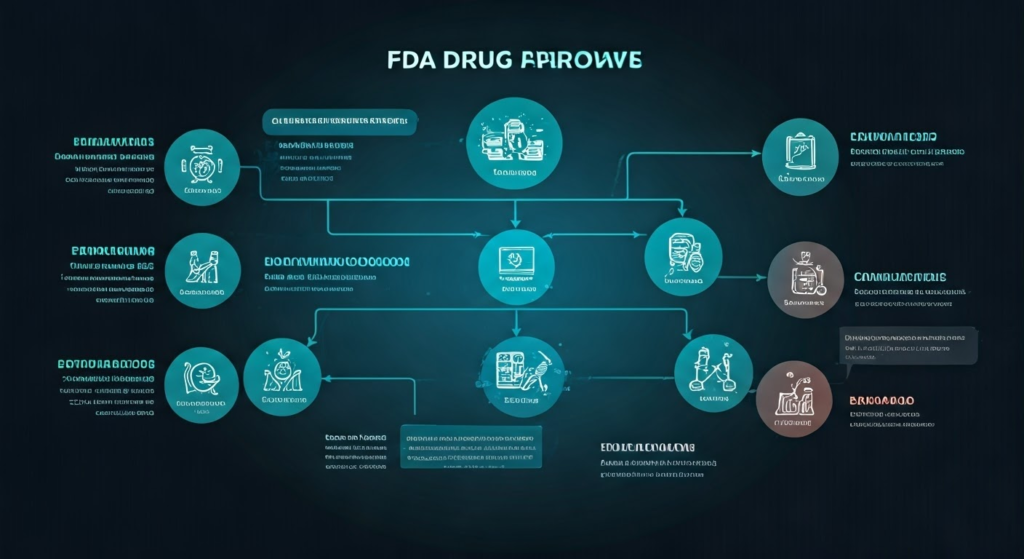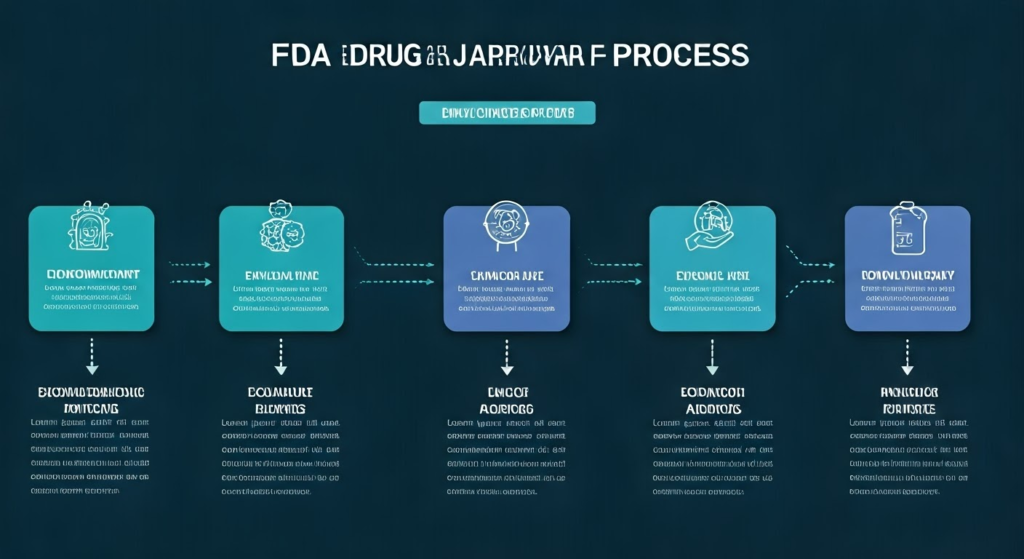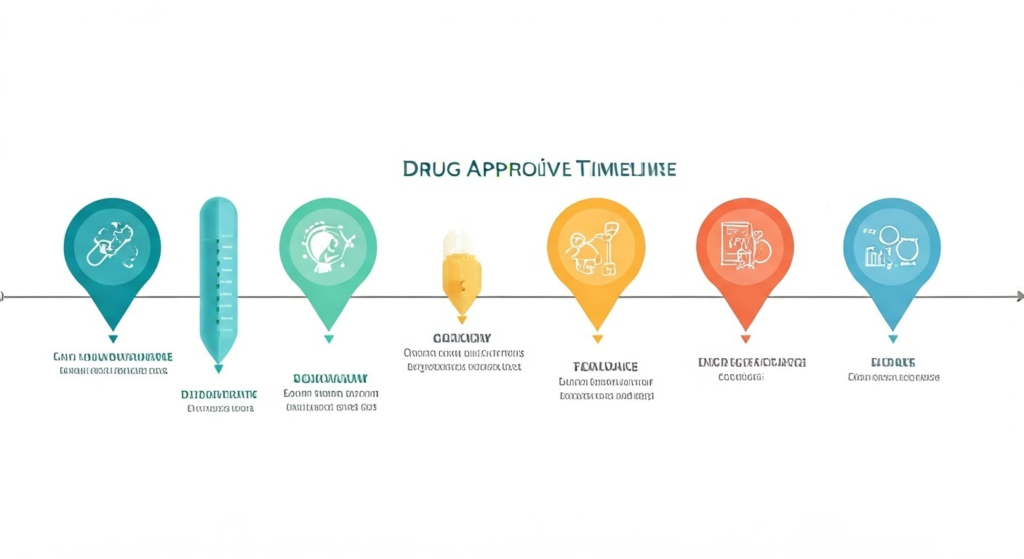Simplifying FDA Drug Approval Steps

Key Highlights
- The FDA drug approval process is a rigorous, multi-phase procedure designed to ensure the safety and effectiveness of new medications.
- It involves preclinical research, clinical trials (Phases 1-3), New Drug Application (NDA) submission, and post-marketing surveillance (Phase 4).
- The process typically takes 12-15 years and costs billions of dollars.
- The FDA offers expedited pathways, including Fast Track, Breakthrough Therapy, and Priority Review, for drugs addressing serious conditions.
- Public safety is paramount, with ongoing monitoring through the FDA MedWatch Program.
1. Understanding the FDA Approval Process

Navigating the FDA approval process requires a good understanding of different steps in drug evaluation. It starts with a drug maker submitting an investigational new drug application and ends with final approval. Each stage is important to make sure that a drug is safe and works well. Clinical trials are essential as they help gather clinical data on the drug’s benefits and risks. To do well in getting a new drug approved, you need to know how FDA reviewers look at things and understand the rules they follow. This knowledge is important to guide a new drug through the approval process.
2. Timeline of Drug Approval: How Long Does it Take?

The FDA drug approval process usually takes about 12 years. This time includes several steps, starting from preclinical testing to final approval. It involves clinical trials, review phases, and regulatory decisions. All these steps help make sure that new drugs are safe and effective.
3. The 4 Phases of Drug Approval: What You Need to Know
Drug approval has 4 important phases of clinical trials. Phase 1 tests safety using healthy volunteers. Phase 2 looks at how well the drug works and checks for side effects. In Phase 3, a larger group is studied to see their response. Finally, Phase 4 keeps track of the drug after it is approved to find any long-term problems and gather additional information. Each phase has a special role in checking a drug’s safety and effectiveness before it is sold. Understanding these phases helps people manage the drug approval process better.
4. Navigating the New Drug Application (NDA) Process
Navigating the new drug application (NDA) process means sending a complete file to the FDA for review as the sponsor of a new drug. This file includes all the safety and effectiveness data, including human data collected from clinical trials. The FDA checks every detail to make sure all standards are met before giving marketing approval. The NDA process is complex. It requires drug companies to work closely with FDA reviewers. This teamwork helps to quickly address any concerns and ensures the new drug is evaluated on time.
5. Special Designations for Expedited Approval
The FDA approval process has special designations that help speed up how fast some drugs get approved. These designations focus on drugs that meet urgent medical needs or offer major advantages over current treatments. Programs like the Fast Track process, Breakthrough Therapy designation, and Priority Review allow faster checks and approvals for these medicines. By using these designations, drug companies can deliver important treatments to patients more quickly.
6. Behind the Scenes: Who Sits on an FDA Advisory Board?
The FDA advisory board is made up of experts from different areas like medicine, science, and public health. They give independent advice on drug approvals based on what they know. This helps to make sure that each drug is carefully looked at before a choice is made. This mix of experts is very important in the FDA approval process.
7. The Cost of Getting a Drug to Market: Breaking Down the Expenses
Understanding the costs involved in the FDA drug approval process is very important for drug companies. Creating and launching a new drug is expensive. It includes costs for research, trials, making the drug, and getting the right approvals. These costs can differ a lot based on how complex the drug is and how long the approval process takes. Companies need to plan their budgets well. This helps them deal with these financial challenges and successfully bring their new products to market.
8. Final Approval: What Happens Next?
After the FDA gives final approval, the drug can be sold to consumers. After approval, the company will watch for any bad effects. They will do this with post-marketing surveillance. They also need to meet all the rules and regulations.
9. Ensuring Safety with FDA MedWatch Program
By using the FDA MedWatch program, people and healthcare providers can report bad reactions or issues with FDA-regulated products. This includes prescription medications, medical devices, and over-the-counter drugs. The program helps monitor the safety of these products after they are approved. It allows for quick detection of problems and action to keep public health safe. Reporting issues through this program helps keep track of drug safety and improves how regulations work.
Frequently Asked Questions
What are the different phases of FDA drug approval?
The FDA drug approval process is a long journey that drug companies must follow to sell a new drug. A key part of this journey is clinical trials. These are carefully designed studies that include people.
Clinical trials for a new drug are usually split into four phases:
- Phase 1: This phase checks the drug’s safety. It finds a safe dose and watches for side effects.
- Phase 2: Here, the focus is on how well the drug treats a specific condition. It also looks at safety again and tests the best dosages.
- Phase 3: This phase includes a bigger group of people. It confirms if the drug works, checks for side effects, and compares it with other treatments.
- Phase 4: This phase happens after the FDA approves the drug. Researchers keep an eye on its long-term effects and safety in real life.
Each phase of the clinical trials adds more information about the new drug’s safety, how well it works, and any risks or benefits.
What criteria does the FDA use to evaluate a new drug for approval?
The FDA checks new drugs through a careful process to ensure that drugs marketed in the United States are safe and can work well for the purpose it’s made for. The evaluation looks at more than just the active ingredients; it also considers acceptable ingredients in the drug’s formula, how it is made, and any possible interactions with other substances.
Here are the key points the FDA looks at during drug evaluation:
- Safety: The drug needs to be safe enough. This means that the good effects should be greater than any known risks for the patients who will use it.
- Efficacy: The drug must show it can treat the specific condition it is meant for. There should be strong proof from clinical trials that it can deliver meaningful results.
- Quality: The drug must follow strict manufacturing rules to guarantee that it will be of high quality, pure, and strong.
The FDA closely reviews all information sent by the drug company regarding prescription drugs. This includes early research, results from clinical trials, details about how the drug is made, and proposed labels. If the FDA finds that the good parts of the new drug are greater than its possible risks and evaluates the drug’s safety, they will approve it for sale.
How long does the FDA drug approval process typically take?
The FDA drug approval process takes a long time and is very detailed. On average, it takes about 12 to 15 years for a new drug to go from the first discovery to being available for patients.
This long timeline includes every step of drug development. It starts when scientists find a promising compound and ends after many clinical trials. The time the FDA takes to review a drug can change. It depends on how complicated the drug is and how complete the application is.
Even though drug approval takes a long time, it shows that the FDA wants to make sure only safe and effective drugs are sold. This careful process is important for protecting public health.
Are there any expedited pathways available for certain types of drugs to receive FDA approval?
The FDA understands how important it is to get new treatments to the American public with serious health problems faster, including those that showcase significant health benefits. To help with this, they have created quicker ways to approve drugs. These paths make sure that new medicines are developed and checked quickly but still meet the FDA’s strict rules for safety and effectiveness.
Here are some of the quicker ways to approval:
- Fast Track: This helps develop and review drugs that treat serious conditions and fill gaps in medical needs. It allows for easier communication with the FDA, which could speed up the approval process.
- Breakthrough Therapy: This is for drugs that show a big improvement over current treatments for serious issues. It gives extra help and guidance from the FDA during the whole development.
- Priority Review: This speeds up how quickly the FDA looks at a drug application. The goal is to make decisions in six months instead of the usual ten, especially for drugs that bring significant new benefits for treating or preventing serious conditions.
These faster paths are key for getting new and effective treatments to patients with serious illnesses sooner.
https://www.fda.gov/drugs/development-approval-process-drugs
https://www.fda.gov/media/82381/download
https://www.accessdata.fda.gov/scripts/cder/daf/index.cfm
https://s100.copyright.com/AppDispatchServlet
https://www.accessdata.fda.gov/scripts/medwatch/medwatch-online.htm

